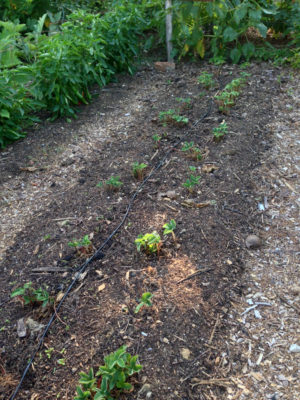A VERY GOOD YEAR, SO FAR
/5 Comments/in Fruit, Gardening, Planning, Vegetables/by Lee ReichBye, Bye Beetles
So far, this growing season has been one of the most interesting ever. Could it be global warming? Perhaps. Perhaps it’s all a legacy from the relatively snowless winter with long periods of cold, but not frigid, temperatures. Perhaps it was spring’s two nights of plummeting temperature that followed a warm spell. Perhaps it was this summers extremes of dry and wet periods. Perhaps all that’s from global warming. Perhaps . . .
All I know is that it’s all been pretty good. As I wrote previously, for the second year in a row, Japanese beetles made their entrance on time in June, and then, as if from stage fright, skittered away. Or never emerged from the soil. Or never hatched from eggs laid in the soil. Or the eggs never got laid last summer.
For years, Mexican bean beetles would lay eggs on my bean plants, and those eggs would hatch into voracious larvae and then adults that would shred bean leaves. I was able to harvest enough beans for fresh eating and freezing only with succession planting of bush beans every couple of months.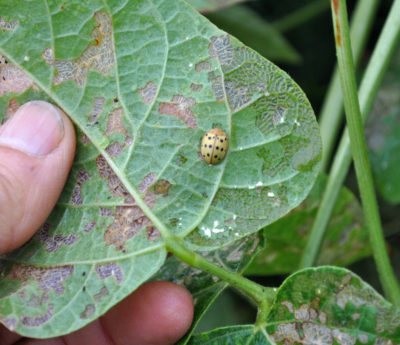
For the past couple of years, only a few beetles show up here and there; nothing to worry about. So now an early sowing of bush beans provides the first plates of beans, and then passes the torch on to pole beans, which unlike bush beans, keep yielding till the end of the season. Bush beans peter out after a few pickings.
(I did spray neem oil and the biological insecticide ‘Entrust’ a few years ago. Perhaps that broke the Mexican bean beetle cycle here. Perhaps it was the mere threat of a wall at the Mexican border . . . No, no, that can’t be it. Mexican bean beetles have established themselves north of the border for many generations, human and beetle. Throughout the country over many decades, this pest has waxed and waned in its severity, at times turning its taste to soybeans, sometimes to lima beans. My beetles never showed an appetite for my soybeans.)
Two other pests that, I hope, can now be off my radar are scale insects on the greenhouse figs and flea beetles on the eggplants. That status comes with some effort on my part: weekly sprays, until recently, of “summer oil.” I expect to have to maintain those efforts every season. (Late update: I saw a few scale insects on the figs so did have to spray again.)
Skyrocketing Corn, De-Luscious Blueberries
This season’s interests aren’t all about pests.
Right now, corn stalks are as high — no, higher — than an elephant’s eye. (For journalistic accuracy, I looked up the height of an elephant’s eye. One report on the web, that fount of highly accurate information, reported the median height at 98 inches.) I just stepped away from my desk to measure the actual height of my corn, and it topped out at about 10 feet high. And that’s the variety Golden Bantam. I’ve grown it for many years, during which it always topped out at 6 or 7 feet.
The first ears of this rich-tasting, old variety should be ready any day now. Will they also seem to be on steroids?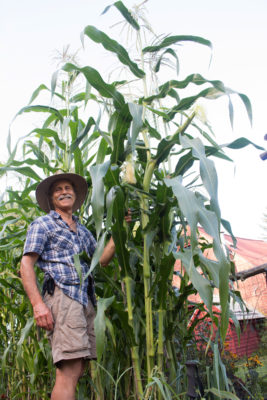
No explanations for this corny behavior jump out. Year after year, the soil gets the same one-inch depth of compost, the 3-foot-wide corn bed is planted in two rows of hills, thinned to 3 stalks per hill, with each hill 2 feet apart in the row, and the bed is drip irrigated. Mislabeled seed can’t explain the phenomenon because this season’s popcorn (Dutch Buttered and Pearl) and polenta corn (Otto File) also have higher aspirations. Anyway, I’m not complaining.
Apples never grow well here. This low lying valley is a sink for colder, moister air that, along with the backdrop of thousands of acres of forest, is a haven for apple pests. This season, with some spray assistance from me, the apple crop is relatively heavy and attractive. Apples, in those years when I do get a decent crop, are especially tasty here.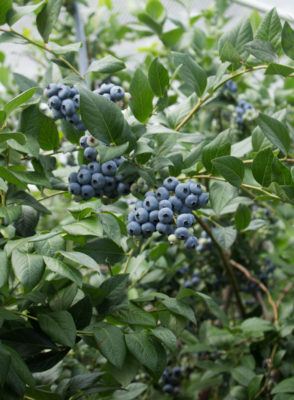
I have to tip my hat, once again, to blueberries, my favorite fruit and the most consistent performer among my many fruits. I have never not gotten a good crop of blueberries, come hell or high . . . 17 year cicadas, hurricane Irene, late frosts, etc. This season, canes are arching to the ground with a particularly heavy crop of berries.
What will next year hold? An even better growing season?
ROT AND FLOWERS
/0 Comments/in Flowers, Fruit, Gardening, Pests, Planning/by Lee ReichBrown Rot Strikes Again
The plan was for me to be now sinking my teeth into the soft, juicy, rich flesh of my Oullins golden gage plums. The tenuous start this past spring, with a freak late freeze that sent temperatures plummeting into the low teens, had me worried. The trees shook off the cold and, when warmer weather returned, burst into snowballs of white blossoms. Tiny fruitlets that followed those blossoms have swelled to the bountiful crop now dangling from the branches.
The plan has been foiled — by brown rot disease. Almost every plum, just as its skin starts to shade towards ripeness, becomes spotted with fuzzy, gray droplets that, with good weather (good for the fungus, that is), soon covers the fruit.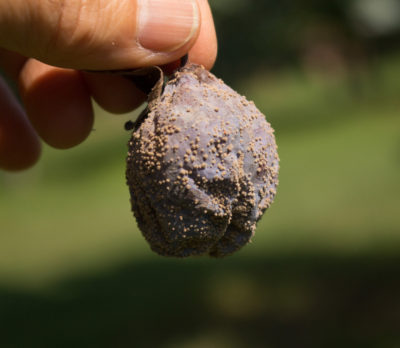
Brown rot was not unexpected, and a counterattack was planned. All through spring, before blossoms even unfolded, I doused the plant with insecticide and fungicide sprays. Insecticides help control brown rot by preventing insects, most notably plum curculios, from laying eggs in the developing fruitlets. Even if the egg-laying itself doesn’t cause the fruit to drop, holes left behind provide easy entrance for the brown rot fungus.
Perhaps I was too lenient, using relatively benign (to us humans, that is), organically approved sprays. ‘Surround’, a commercial formulation of kaolin clay for the insects. And sulfur, a naturally occurring mineral, for the brown rot fungus.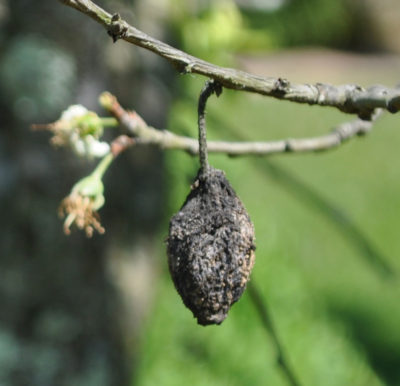
That’s not all. Gathering up infected fruits cuts back the number of new disease spores that waft among the branches looking for new fruits to infect. In fall and winter, those infected fruits are easily recognized as blackened, dry “mummies.” They lose their dryness and come to life, fungal life, with spring’s warmth and moisture. I’ll gather them up also. I’m hoping my ducks develop a taste for the fresh, dropped, rotten fruit; so far, they seem to be picky eaters.
My late winter pruning of the trees should also have helped reduce brown rot disease. Removing enough stems and limbs to allow those that remain to bathe in light and breezes allows for quicker drying from dew or rain.
The Disease Triangle
Three conditions must be satisfied for any disease, whether in animals or plants, to take hold: inoculum must be present, the host must be susceptible, and the conditions must be suitable for disease development. Check, check, check for my Oulin plum (a susceptible host plant) getting brown rot here in the Hudson Valley, throughout most of the humid eastern U.S., in fact. We have plenty of wild and cultivated plums and related plants here to provide brown rot inoculum from infected fruits, and the weather is usually just about perfect (for the disease, that is).
But Oullin isn’t the only great-tasting plum. How about a less susceptible host variety? Fungi are picky eaters, and varieties of plants vary in their susceptibility to specific diseases.(Unfortunately, most gage-type plums, which are heart-shaped, with greenish flesh, are very susceptible to brown rot.)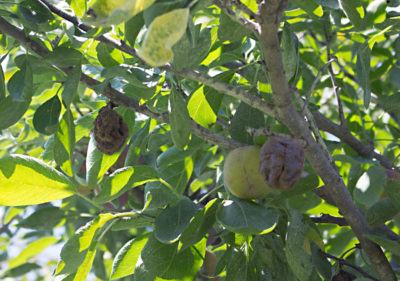
My plum trees are grafted to multiple varieties. The variety Shiro also finds a home on the tree grafted to Oullin. This year, and in years past, Shiro seems to be somewhat resistant to this disease. And I see that Cummins Nursery has a variety called Jam Session that also is resistant. This past spring I also planted the varieties Alderman and Superior, which are American hybrids with some alleged resistance.
As consolation, plums are, at least, less susceptible to this scourge than are peaches and apricots.
Flowers to the Rescue?
I’m planning and planting for flowers for next season and for years to come, with perennials.
I could, of course, just purchase some potted plants to plug into the ground now or next spring. I could buy seeds and sow them next spring. Instead of those two options, I’m sowing seeds now, a time when, admittedly, there’s not that frenzied urge to plant seeds as in spring.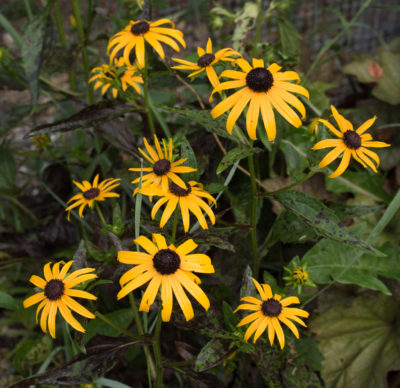
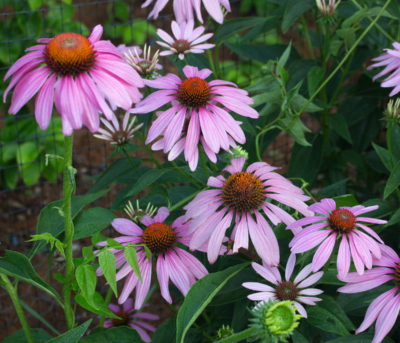
One packet of seeds can — should — result in oodles of plants, plenty to plant and to give away. Sown now, the seeds should grow into plants that will be large enough to weather autumn, then winter’s, cold. Plants should also be large enough to flower next year. Their experience of cold, known as vernalization, will further coax them on to flower. Spring sown perennial flower seeds often don’t flower their first season, no matter what their size, because they have yet to be vernalized.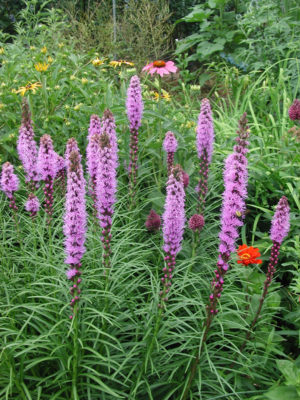
I’m sowing purple coneflower (Echinacea), black-eyed-susan (Rudbeckia), and blazing star (Liatris). They’re all in the daisy family, a family known not only for its good looks but also for providing nectar to attract and help support beneficial insects. If I plant enough, perhaps the increased number of beneficial insects will significantly decrease the number of plum curculios and other plum fruit insects resulting in, because of less insect scarring of fruit, significantly less brown rot of my plums.
It’s a stretch but the flowers, anyway, are very pretty.
PESTS, INCLUDING ME(?)
/0 Comments/in Fruit, Pests, Planning, Soil/by Lee ReichWatch Out, for Black Walnuts
Citizen scientists (that could be you and me), look up! At black walnut’s leaves. At the recent meeting of the New York Nut Growers Association (www.nynga.org), Karen Snover-Clift of Cornell University went over the ins and outs of “thousand cankers disease of walnut.”
Like Dutch elm disease — it pretty much wiped out American elms, once valued for creating a cathedral effect as their branches arched over tree-line streets — thousand cankers disease is spread by an insect. But the walnut twig beetle is only part of the problem. When it bores into the bark, it spreads a fungus that clogs up a tree’s “tubes.”
With Dutch elm disease, once a tree is infected, the fungal culprit spreads within the tree to kill it. Not so with thousand cankers disease. With this disease, death comes from fungal infection that follows thousands of dark, dead cankers of insect feeding.
Who cares about black walnuts? I do. Each fall the trees bear an abundance of nutritious and delicious nuts. (Not delicious to everyone; the strong flavor does not appeal to everyone. But no reason any food should appeal to everyone unless you’re MacDonald’s.) And, quoting from The Tree Book, written in 1914 by Julia Rogers, “The black walnut is majestic as a shade tree — a noble ornament to parks and pleasure grounds. It needs room and distance to show its luxuriant crown and stately trunk to advantage. Then no tree excels it.”
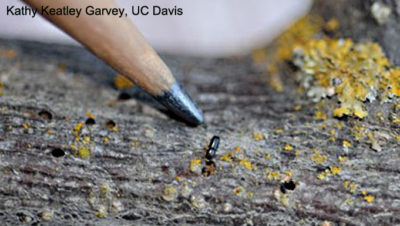
Walnut twig beetle
And finally, black walnut yields among the most beautiful of woods for furniture and gun stocks. Again quoting Ms. Rogers, the wood has “silvery grain, rich violet-purple tones in the brown heart wood [and] exquisite shading of its curly veinings.”
Thousand cankers disease moved into southwestern U.S. from Mexico (would a wall keep them out? will Mexico pay for it?) and has remained mostly in that region. Black walnut is native to eastern U.S., but the tree has occasionally been planted out west. More importantly, the disease has recently reared its ugly head at a few locations in the east. If infected trees can be identified, the disease can be contained to check its spread.
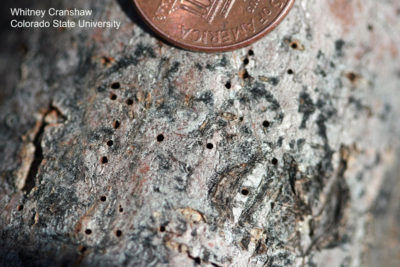
Thousand cankers
Any tree with an infected branch is usually dead by the end of the season!
So look up, scan the tops of any black walnut trees for limbs that are dead or show flagging foliage. Your job, and my job, is to look for these trees and then report them.
For a more thorough treatment of thousand cankers disease, as well as reporting guidelines, see www.thousandcankers.com. A good start in confirming the disease would be to take some good digital photos and send them to the state diagnostic laboratory, the county Cooperative Extension office, or department of environmental conservation.
Chipmunks, Still Cute Here
I find chipmunks cute, as I’m sure everybody would — except for anyone for whom chipmunk is a garden pest. This year, for some reason, an especially good crop of chipmunks are scurrying about. I see them everywhere, except on my farmden. Their absence here could be attributed to my dog friends Sammy and Scooter, and my cat friend Gracie.
I would not tolerate chipmunks if they were to eat my blueberries, my filbert nuts, my . . . pretty much anything I’ve painstakingly planted and nurtured. Besides dogs and cats, traps also are effective.
No, I’m Not a Strawberry Pest
As if plants didn’t have enough pest problems. I recently attacked my strawberry bed with my scythe, swinging the sharp blade low enough to cut off every last leaf from the plants. No, I’m not just another plant pest, trying to kill plants; I was “renovating” the bed, preparing it for next spring.
Shearing off the leaves not only removes leaves, but also disease spores on the leaves that inevitably find their way into any strawberry bed. Obviously, I raked up the old leaves and carted them over to the compost pile.
The next step in renovation was to pull out any weeds in the bed. The major weed in the bed was . . . strawberries. Strawberries spread by creeping stems along which grow new plants that take root, making them usually their own worst weed. Each plant needs about a square foot of elbow room to realize its full potential of one quart of berries per plant.
So I ruthlessly ripped out enough plants so that my 3-foot-wide bed was left with a double row of plants spaced a foot apart. Older plants get decrepit with age, so those were the first to go.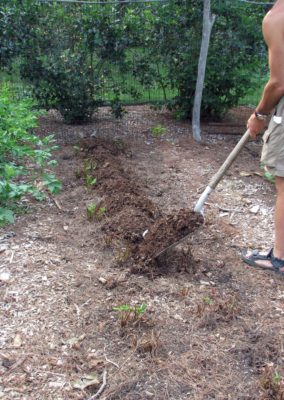
Finally, icing on the cake. I laid a 1 inch depth of compost all over the bed and tucked up to each of the remaining, leafless strawberry crowns. A little fertilizer and straw, pine needle, wood shavings, or any other weed-free organic material would be almost as good.
It’s been a few weeks and already new leaves are sprouting. The plants are on their way to a healthful and healthy crop of sweet, juicy berries next spring.